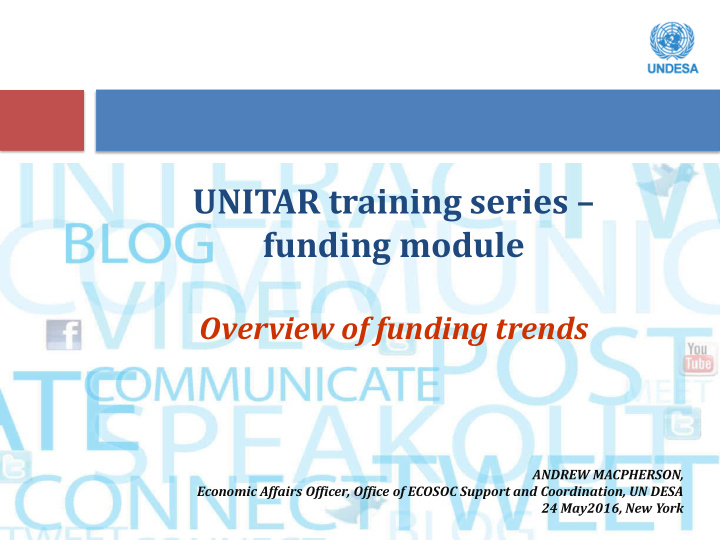



UNITAR training series – funding module Overview of funding trends ANDREW MACPHERSON, Economic Affairs Officer, Office of ECOSOC Support and Coordination, UN DESA 24 May2016, New York
Volume of funding flows Real change over time of funding for UN-OAD and as share of ODA, 1965-2014 Funding to UN-OAD (real terms, billions $US) Funding for UN-OAD as share of DAC-ODA 30 20% 25 20 15% 15 10% 10 5% 5 0 0% 1965 1970 1975 1980 1985 1990 1995 2000 2005 2010 UN-OAD funding UN-OAD share of DAC-ODA In 1997, non-core funding exceeds core funding for the first time
Volume of funding flows Channels of multilateral aid in 2014 Total use of multilateral system (2014): $62.3 billion Other 17% World Bank United Nations Group development 22% system 31% Regional European Development Commission Banks 22% 8% Source: OECD.Stat UN development system is the largest channel for direct multilateral aid
Volume of funding flows Real change over time of funding for UN-OAD, 1999-2014 30 25 Humanitarian- +202% assistance related Billions of 2013 $US 20 +136% +1% Total 15 + 114% +190% 10 Development related +101% 5 +20% 0 1999 2002 2005 2008 2011 2014 Development core Development non-core Humanitarian core Humanitarian non-core 95% of funding growth in last 15 years has been in the form of earmarked resources
Volume of funding flows Real change over time of funding for UN-OAD, since 2007 TCPR 30 25 Humanitarian- +113% assistance related 20 +102% Billions of 2013 $US +56% Total 15 + 36% +17% 10 Development related +11% 5 +2% 0 2007 2010 2013 Development core Development non-core Humanitarian core Humanitarian non-core Since 2007, almost all growth has gone to finance humanitarian activities.
Volume of funding flows Contributions received by UN entities in 2014 Total contributions: $28.4 billion 6 000 WFP 5 000 Non-core resources (Millions ) 4 000 UNDP UNICEF UNHCR 3 000 2 000 24 WHO others non-core > core FAO UNRWA 1 000 UNESCO core > non-core UNFPA ILO 0 0 250 500 750 1 000 1 250 1 500 1 750 Core resources (Millions) (Size of bubbles are proportional to total contributions) Resources are concentrated in a relatively small number of UN entities
Sources of funding Main groups of funding sources in 2014 Total contributions: $28.4 billion MDTFs, 3% US, 21% Others 16% UK, 7% Governments 77% Next six largest donors 22% European Commission Others, 23% 7% The UN continues to rely heavily on a few Government donors
Sources of funding Main financial contributors in 2014 6 000 United States 5 000 Non-core resources (millions $US) 4 000 3 000 NGO/Private European Commission 2 000 United Kingdom Local resources Germany non-core > core Global funds Japan 1 000 Canada Norway Netherlands MDTFs Developing Australia core > non-core Sweden countries 0 Denmark - 100 0 100 200 300 400 500 600 700 800 900 Core resources (millions of $US) (Size of bubbles are proportional to total contributions)
Quality of earmarked funding Volume of resources channeled through different non- core funding modalities in 2014 Local resources Humanitarian Multi Restrictively earmarked by individual 6% donor trust funds 5% donors to specific projects Development Multi Pooled 14% donor trust funds 4% Bi-multilateral Thematic Funds 75% (Entities) 3% Global/vertical funds 5% Joint Programmes 1% One-off $500 million contribution to the Saudi Humanitarian Fund for Iraq in 2014
Distribution and Fragmentation Expenditures by region in 2014 $28.4 billion Europe 3% Regional/global 14% Western Asia Americas 17% Programme support 6% /management /administration 11% Other 15% Asia/Pacific 14% Programme activities - Not attributed 4% Country level Africa 31% 71% 53% of country-level expenditures to LDCs; 41% of country-level expenditures to Fragile States (World Bank definition).
Distribution and Fragmentation Country-level UN-OAD expenditures as a share of ODA in 2013 (excludes local resources) 100% 60 100% 84% Cumulative share of total # of programme countries 50 80% 60% 40 60% 60 30 (41%) 40% 29% 20 26% 33 26 20% 10 (23%) (18%) 20 7 (14%) (5%) 0 0% > 40 % 30-40% 20-30% 10-20% < 10% Share of total ODA at country level Number of programme countries Cumulative share of expenditures 16% of UN resources were spread-out thinly across 60 programme countries
Competition among entities Survey question: To what extent to which UN entities compete with each other for donor funding? 50% 2014 2015 46% 40% 42% 30% 25% 20% 21% 20% 20% 17% 10% 9% 0% To a large extent To a moderate To a small extent Not at all extent Source: 2014 and 2015 Survey of Programme Country Governments
Cost Recovery High-level breakdown of expenditures in 2014 100% 80% 60% 91.6% 40% 68.1% 20% 0% Core Non-core Programme activities Source: UN-DESA survey of Non-programme activities UN entity headquarters Significantly higher share of core resources are being spent on non-programme costs (i.e. programme support, management, administration, etc.)
Cost Recovery Another contributing factor to core/non-core imbalance Growing core / non-core imbalance Increased incentive for Greater subsidization of non- donors to provide non-core core activities from core funds resources
Thank you
Recommend
More recommend